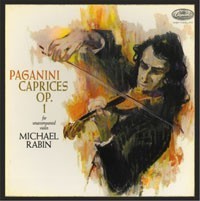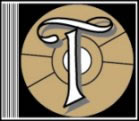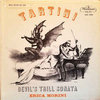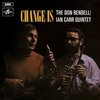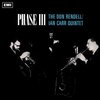AAA 100% Analogue This LP was Remastered using Pure Analogue Components Only from the Master Tapes through to the Cutting Head
EMI Capitol Testament - SPBR 8477 - 180 Gram Virgin Vinyl
AAA 100% Analogue - Mastered at Abbey Road - Pressed at Pallas
Testament has revived these classic titles from the EMI catalog using only the original EMI master tapes,cut onto lacquer at EMI's Abbey Road Studios and mastered using full analog techniques throughout production.
Paganini Caprices op. 1 for unaccompanied violin Michael Rabin
An absolutely stunning vintage box set featuring the great Michael Rabin on solo violin.
This is a classic performance by one of the greatest violinists of the 20th century.
Not to be missed by fans of violin, Rabin, Paganini or great sound!
Includes two LPs, a box and a four-page insert.
If Bach's "Sonatas and Partitas" the Old Testament of the violin literature are, so are the 24 Caprices for solo violin the new. It is not only at that time, for most active violinists, that technically feasible mallets, which are technically possible on the instrument, reach the outermost limits; There are also testimonies of the deep, and underestimated, musicality of the Genoese. Whose contemporaries, on the basis of this collection (especially the particularly effective Caprice), repeatedly entrusted him with the devil himself. However, more enlightened colleagues (including those whose activities were less apparent in the violinist, pianistic or orchestral) were fascinated by the tremendous expansion of musical possibilities opened by Paganini with this collection of "whims", which is why the effects of the work cycle are hardly over-pronounced Is. Michael Rabin, who presented his impressive record debut with 11 of the Capricenes in 1950 at the age of 14, played it completely in 1958.
The result was the coronation of the tragically short discography of this "wonderer", a hardly accessible hour of the violin playing and until today a saint Gral among violin collectors. Already the first Caprice raises one again and again almost from the chair: Rabin's elan is hardly to be grasped; One may argue about whether the one who plays, is animated or possessed-with earthly things it can scarcely happen here. What follows is a breathtaking ride through the infernal difficulties of the sheet music, through absurd doublehands, flageolets, pizzicatos and fingerbreaker runs, all of which can only be perceived by Rabin when they know about her - for he transforms every bravura piece into fascinating, enthralling Music.
Without a doubt, this recording is one of the most important documents which has witnessed the technical possibility of sound recording since its invention. Testament has finally in its original form (actually, the box is a loving facsimile of the original edition!) Made and phenomenal sound quality available again - this Classic Reissue is likely to be clarified so that ...
Separately, Paganini's Caprices (24) are among the most difficult pieces ever written for the violin. Together, they are the very definition of violin virtuosity. And not just technical virtuosity, but tonal and even emotional virtuosity. Playing the notes perfectly is the beginning -- not the end -- of performing the Caprices: playing the notes with exquisite beauty and emotional expressivity is the goal of performing the Caprices. Michael Rabin can do all of that and he makes it sound easy. In this 1958 Capitol recording, Rabin plays all the absurdly impossible notes of Paganini's Caprices with an unfailingly beautiful tone. Better than that, Rabin gets beneath the notes to the gloriously beautiful, wonderfully expressive music in the Caprices. One could almost forget how ridiculously difficult these pieces are when listening to Rabin's passionate, contemplative, dramatic, comic, seductive, and heroic interpretations. But when one realizes how difficult the pieces are and how easy Rabin makes playing them sound, one is amazed all over again. This is one of the greatest solo violin performances ever recorded.
When Michael Rabin made his official concert debut at Carnegie Hall in 1950, at the age of 14, conductor Dimitri Mitropolous said of him: "He is really the genius violinist of tomorrow, equipped with all that is necessary to be a great artist and to give great thrills to the musical world. He is a blessed boy and already completely devoted to his mission."
Rabin went on to become hailed by critics and audiences for his brilliant performances and became a major American artist before his premature death at the age of 35.
Although Paganini came into the world almost a generation too soon to be a genuine Romantic, he stands as one of the great and fascinating Romantic figures because of the extraordinary impression he made upon the younger generation of artists, as well as on a vast public. His violin-playing was of a kind that had never before been witnessed; and, besides, he presented a physical image so strange as to seem almost unearthly, though to some he seemed comic. He was tall, gaunt, even skeleton-like; he wore his long black hair as a frame around his pale, narrow face; his manner on the platform was austere. It was popularly believed that he had won his astounding virtuosity through a pact with the devil himself, and many thought that he was the very image of the fiend. Other dark rumors were circulated about him, particularly that he had spent some years in prison, though actually he had amused himself during the time in question in a quiet Tuscan retreat with a lady of noble rank and a guitar for which he had temporarily forsaken his violin. Other musicians - Liszt, Chopin, Berlioz, Schumann - were far more typically Romantic than he was in both character and artistic beliefs, but he had one quality that none of them possessed: there was something weird, eerie, Gothic, even macabre about him. He belonged in literature rather than in real life. Einstein called him Hoffmannesque.
In order to safeguard what he regarded as professional secrets, Paganini published very few of his compositions, and he placed prohibitive prices on his manuscripts in order to discourage importunate publishers. A dozen sonatas for violin and guitar, six quartets for strings and guitar, and the 24 Caprices for violin solo were the only works that circulated during his lifetime. Of these, the Caprices are by far the most important.
Side ONE
1. No. 1 - E major
2. No. 2 - B minor
3. No. 3 - E minor
4. No. 4 - C major
5. no. 5 - A minor
Side TWO
1. No. 6 - G minor
2. No. 7 - A major
3. No. 8 - E flat major
4. No. 9 - E major
5. No. 10 - G minor
6. No. 11 - C major
Side THREE
1. No. 12 - A flat major
2. No. 13 - B flat major
3. No. 14 - E flat major
4. No. 15 - E minor
5. No. 16 - G minor
6. No. 17 - E flat major
7. No. 18 - C major
8. No. 19 - E flat major
Side FOUR
1. No. 20 - D major
2. No. 21 - A major
3. No. 22 - F major
4. No. 23 E flat major
5. No 24 - A minor
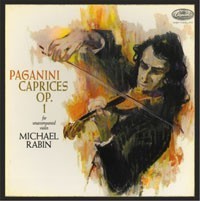
Testament has revived these classic titles from the EMI catalog using only the original EMI master tapes, cut onto lacquer at EMI's Abbey Road Studios and mastered using full analog techniques throughout production.
